Students can access the CBSE Sample Papers for Class 12 Informatics Practices with Solutions and marking scheme Term 2 Set 5 will help students in understanding the difficulty level of the exam.
CBSE Sample Papers for Class 12 Informatics Practices Term 2 Set 5 with Solutions
Maximum Marks : 35
Time : 2 hours
Instructions:
- The question paper is divided into 3 sections – A, B and C.
- Section A, consists of 7 questions (1-7). Each question carries 2 marks.
- Section B, consists of 3 questions (8-10). Each question carries 3 marks.
- Section C, consists of 3 questions (11-13). Each question carries 4 marks.
- Internal choices have been given for question numbers -1, 3, 8 and 12.
Section – A
(Each question carries 2 Marks)
Question 1.
Alakhya is new to networks. He has learnt various terms like server, client, MAC and IP address. He also came to know about the transmission mediums like radio waves, coaxial cables etc. He understood that certain devices are also important role players in a network . Explain him in short, the roles of following devices.
(i) Modem
(ii) Repeater
Or
(i) Hub
(ii) Switch
Answer:
(i) Modem (MOdulator DEModulator): It is a device that converts digital signal to analog signal (modulator) at the sender’s site and converts back analog signal to digital signal (demodulator) at the receiver’s and, in order to make communication possible via telephone lines.
(ii) Repeater: It is a network device that amplifies the signals, so that they can travel to a larger distance. Repeaters are amplifiers that help to carry forward the signals to larger distances.
Or
(i) Hub It is a multiport concentrator that connects multiple computers in a local area network.
(ii) Switch It is a network device that connects multiple segments of a LAN. It can filter network traffic and it also shares the bandwidth.
![]()
Question 2.
(i) Ashok steel industries was suggested by their network partners to install a switch in place of the previous hub installation. Explain them the use of a switch and why is a switch called an intelligent hub?
Answer:
A switch is a networking device which is used to connect different LAN segments of a network. A switch also supports packet filtering and forwarding between LAN segments.
A switch is called an intelligent hub because before simply forwarding a packet it checks for the intended destination for the packet and forwards it to that destination only, this is called packet filtering. While a hub forwards a packet to all the workstations in a network but only destination computer keeps it, rest all the computers drops that packet.
(ii) Ravi frequently listens that certain add-ons or plug-ins are required for looking at certain contents of web page. Help him to understand what are add-ons and plug-ins to a browser ?
Answer:
Add-ons or extension are tools which integrate into your browser. They are similar to regular apps or programs, but only run when the browser runs. Add-ons can allow the viewing of certain types of web content, such as Adobe Flash Player, necessary for Netflix movies and YouTube Videos respectively.
Plug-ins is a piece of software that acts as an add-on to a web browser and gives the browser additional functionality. Plug-ins can allow a web browser to display additional content, it was not originally designed to display.
Question 3.
Ms. Sudha is not clear about the proper use of TRIM() function. Help her to understand the same with one example.
Or
She is also not very conversant with the use of LCASEQ function. Explain her the working of LCASE() function with one example.
Answer:
The TRIM() function removes extra spaces from both sides of a string.
e.g.
SELECT TRIM (“ Double space ”);
Output:

Or
The LCASE() function converts a string to lowercase.
e.g.
SELECT LCASE (“CELLPHONE”);
Output:

Question 4.
Ms. Sumita understands that the data that is fetched in a browser in the form of pages comes from some remote computers that are called as web servers. Help her understand web server better with its types.
Answer:
A web server is a computer that runs websites. It’s a computer program that distributes web pages as they are requisitioned.
The basic objective of the web server is to store, process and deliver web pages to the users. This intercommunication is done using HyperText Transfer Protocol (HTTP).
A web server connects to the Internet and supports physical data interchange with other devices connected to the web.
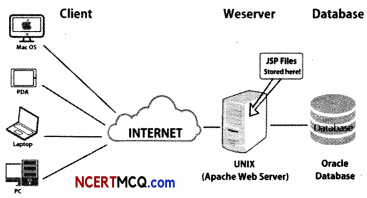
There are various types of web server, which are available for different platforms.
- Apache Web Server
- Microsoft Internet Information Server
- NetScape Enterprise Web Server
- lighttpd
- Sun Java System Web Server
- Jigsaw Server
Question 5.
Neeraj wants to be more clear about where to use the HAVING clause and where to use the WHERE clause of SQL.
Differentiate between WHERE clause and HAVING clause in SQL and help him understand.
Answer:
Differences between WHERE clause and HAVING clause are as follows:
| WHERE Clause | HAVING Clause |
| WHERE clause is used to filter the records from the table based on the specified condition. | HAVING clause is used to filter record from the groups based on the specified condition. |
| WHERE clause implements in row operations. | HAVING clause implements in column operations. |
| WHERE clause cannot contain aggregate function. | HAVING clause can contain aggregate function. |
| WHERE clause can be used with SELECT, UPDATE, DELETE statement. | HAVING clause can only be used with SELECT statement. |
| WHERE clause is used before GROUP BY clause. | HAVING clause is used after GROUP BY clause. |
| WHERE clause is used with single-row functions like UPPER, LOWER, etc. | HAVING clause is used with multiple-row functions like SUM, COUNT, etc. |
Question 6.
Mr. Nandi wants to get grouped aggregate results from a table of employees of his office.
Explain him, how to use GROUP BY clause in SQL to get the desired results.
Answer:
The GROUP BY statement in SQL is used to arrange identical data into groups with the help of some functions, i.e. if a particular column has same values in different rows, then it will arrange these rows in a group. In the query, GROUP BY clause is placed after the WHERE clause.
The GROUP BY clause is used in the SELECT statement. Optionally, it is used in conjunction with aggregate functions to produce summary reports from the database.
e.g.
SELECT SUM(Sal) FROM Emp GROUP BY Desig;
The above command groups the records of the ‘Emp’ table on ‘Desig’ column and displays sum of salaries paid in each.
![]()
Question 7.
ABC advertising has the following record of their salesmen . They want to get certain aggregate results on analysing all the records together. Help them to find these results.
Table: Salesmen
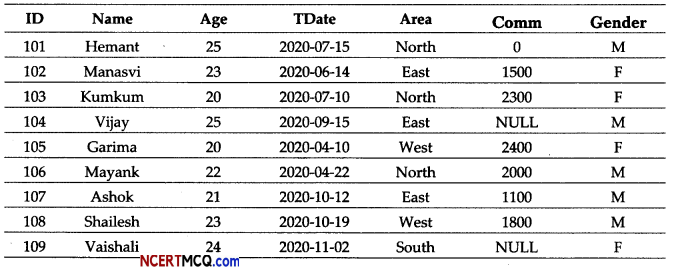
(i) Display maximum commission from the salesmen.
(ii) Display the total commission earned by salesmen.
Or
(i) Display the average commission from the table.
(ii) Find the difference between maximum and minimum commission.
Answer:
(i) SELECT MAX(Conim) FROM Salesmen;
(ii) SELECT SUM(Conim) FROM Salesmen;
Or
(i) SELECT AVG(Conim) FROM Salesmen:
(ii) SELECT MAX(Cor,im)-MIN(Comm) FROM Salesmen;
Section – B
(Each question carries 3 Marks)
Question 8.
Write the statements for the following cases.
(i) Anil wants to see the dayname of a date 15th September 2016.
(ii) Riya wants to see the names of her friends in uppercase. The names are stored in a column Fname of a table FriendTab.
(iii) Bishakha wants to find the square root of 167.
Or
Write the correct SQL statements for the following situations.
Assume a table “Electronics” with fields (Itemld integer, Itemname varchar, Type varchar, Price float)
(i) To extract the last 4 characters of the Itemname in uppercase.
(ii) To round up the price upto 1 decimal place.
(iii) To search the position of the string “sc” in Itemname.
Answer:
(i) SELECT DAYNAME(”2016-09-15”);
(ii) SELECT UCASE(Fnarne) FROM FriendTab;
(iii) SELECT POW(167.O.5);
Or
(i) SELECT UCASE(RIGHT(Itemname.4)) FROM Electronics;
(ii) SELECT ROUNO(Price1) FROM Electronics;
(iii) SELECT INSTR(Itemname,”sc”) FROM Electronics;
![]()
Question 9.
Raj has written certain queries using MySQL functions and is not sure about the outputs . Help him to get the outputs for the following queries.
(i) SELECT P0W(M0D( 11.3) ,2);
Answer:

The MOD(11, 3) returns remainder of dividing 11 by 3 which is 2. The next process is POW(2,2) that returns (2)<sup>2</sup> = 4.
(ii) SELECT SUBSTR( “Antarcti cl ce”, 2,5);
Answer:

The SUBSTR(“Antarcticlce”, 2, 5) function extracts 5 characters from position 2 from the string.
(iii) SELECT YEAR( “2011-09-02”);
Answer:

The YEAR() function returns the year part of a date.
Question 10.
Rituja is trying to produce certain outputs using the INSTR(), POW() and MOD() functions. Help her to produce the desired results for the following statements.
Write the outputs of following SQL statements.
(i) SELECT I NSTR( “Honeybees” , ’’ey”);
(ii) SELECT POW (I NSTR( “Corporate”, ”ra”), 2);
(iii) SELECT M0D(120,2);
Answer:

Section – C
(Each question carries 4 Marks)
Question 11.
Army hospital Patna maintains the following table for its patients . They want certain outputs department wise – like the average charges, total number of patients department wise etc. As a database programmer help them to get the required outputs.

(i) Display each Dept and the total number of patients in each.
Answer:
SELECT Dept . COUNT(*) FROM Hospital GROUP BY Dept;
(ii) Display the department wise average charges.
Answer:
SELECT Dept. AVG(Charges) FROM Hospital GROUP BY Dept:
(iii) Display the total number of unique departments.
Answer:
SELECT COUNT(DISTINCT Dept) FROM Hospital ;
(iv) Display the minimum charges among patients whose name starts with “S” or “R”.
Answer:
SELECT MIN(Charges) FROM Hospital WHERE Pname LIKE “S%” OR Pnanie LIKE “R%”:
Question 12.
A Salesmen table of Excel sales company stores the details of salesman and their commission earned. ‘They want to produce certain aggregate reports areawise and gender wise.What queries do you think will be correct for the following requirements?
Table: Salesmen
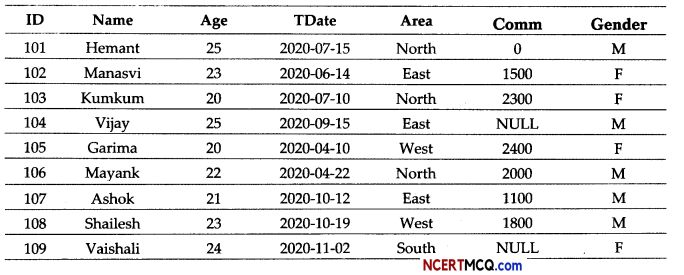
(i) Display minimum commission earned by male salesmen.
(ii) Display maximum commission earned by female salesmen.
(iii) Find the average commission by male salesmen.
(iv) Find the sum of the commission of north area.
Or
The organisation wants to find the outputs of some of the queries as stated below, what do think will be the outputs ?
(i) SELECT MAX(Comm) FROM Salesmen WHERE Area=“East”;
(ii) SELECT COUNT(Area) FROM Salesmen;
(iii) SELECT COUNT!*) FROM Salesmen;
(iv) SELECT COUNT(Comm) FROM Salesmen;
Answer:
(i) SELECT MIN(Comm) FROM Salesmen WHERE Gender=”M”;
(ii) SELECT MAX(Comm) FROM Salesmen WHERE Gencler=”F”;
(iii) SELECT AVG(Comm) FROM Salesmen WHERE Gender=”W”;
(iv) SELECT SUM(Comm) FROM Salesmen WHERE Area=”North”;
Or
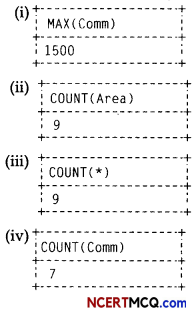
![]()
Question 13.
Mittal Steels have their following buildings as shown in the diagram . The number of computers and the distances between the buildings is given below.
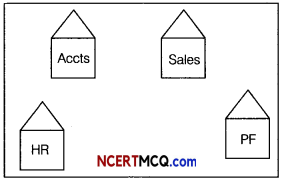
| Building | Number of Computers |
| Accts | 100 |
| Sales | 15 |
| HR | 25 |
| PF | 30 |
| Building | Distance |
| Accts-Sales | 10m |
| Accts-HR | 50 m |
| Accts-PF | 750 m |
| Sales -HR | 400m |
| Sales-PF | 20m |
| HR-PF | 900m |
(i) Suggest a suitable cable layout of connectivity.
Answer:
The cable layout will be as follows:
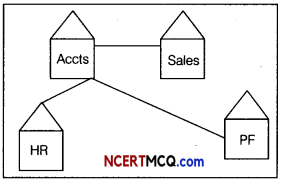
(ii) Which building should have the server?
Answer:
Accts building should have the server as it has the maximum number of computers.
(iii) Which building should have hub/switch?
Answer:
All the buildings should have hub/switch as there are multiple computers in each of the buildings.
(iv) The company wants to connect these buildings with another office in a hilly area of the same city. What kind of network will be formed?
Answer:
MAN (Metropolitan Area Network) will be formed.